The First Expedition - 1826
RevisedRevisions to the grammar and punctuation in these early 19th-century journals allow Smith to tell his story in modern language. These changes make it easier for the reader to understand without altering the intent.
Chapter I
To the Colorado Crossing
At night Manuel, one of my men, ran off, taking a horse, rifle, and ammunition belonging to the company. The two Snake women I had purchased from the Utas [Ute] to save them from torture also ran off with him, undoubtedly by his instigation as he could talk with them, which no other of my men could do; he probably told them he would take them to their own country.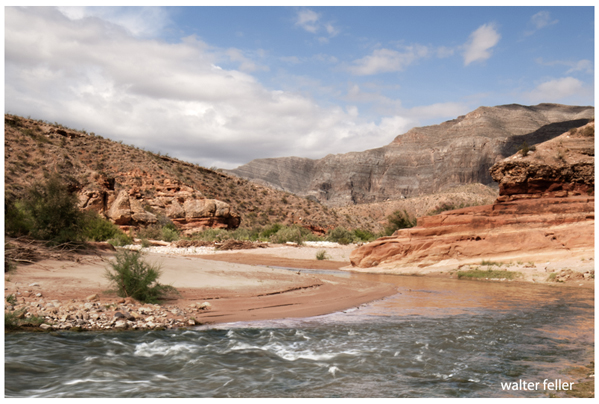
Adams River [Virgin River]
A range of low mountains still keeps on the east, and the country has the same unwelcome appearance on the west; the detached hills are somewhat higher. In the plains are a few antelope, and in the mountains are some ibex.
Our dried meat was now gone in continuing south for two days, a similar country to the last described. Small streams of water from the mountains on the east lose themselves in the plain. Some grass and brush are on these creeks. We came to a small creek running south and followed it for a part of a day, but the country became very rocky and hilly. I was obliged to turn off to the right, where after traveling 8 or 10 miles through a rough country, I came to a stream about 60 yards wide running southwest and coming from the northeast. Consequently, it must head with Ashleys [Sevier] River. Here we killed 2 or 3 antelopes.

Ute Indians in the Uinta Basin c 1873-74
Courtesy Utah State Historical Society
This river I call Adam's River in honor of the present President. I proceeded down this river, and as we found no game or beaver, we had nothing to eat. The grass of the river at this place was of the coarse, tough kinds we call salt and cane grass. The day after I struck the river, I passed a small spot of ground where somebody had raised corn 3 or 4 years since. Although the remains of stalks were about, some of my men could hardly believe it possible in this lonely country. These mounds being irregular convinced me that it was the work of Indians. The wide sandy and shallow river course continues southwest, and the country off from the river, rough, rocky, and red hills with no timber or game.
On the evening of the second day, I had advanced a little ahead of the company to look for a place to encamp. Near a small creek coming in from the west and at a distance of 200 yards, I observed an Indian on a hill. I made signs for him to come to me, but he presented his bow and arrows, and in a moment, I saw 15 or 20 appear. Not considering it safe to remain here, I hastened back to the party and proceeded to the selected encampment. By this time, 20 or 30 were skulking among the rocks. Therefore, I prepared everything for the worst and advanced alone before the camp by making signs and speaking in a friendly tone; I finally succeeded in persuading one of them to come to me.
----------
A Token of Friendship
The bravest in the band, the poor fellow advanced with evident signs of fear, his limbs trembling and his voice faltering. He is holding out a hare or rabbit as a token of friendship. I took it and caressed him, and he immediately sat down. When the others saw that he was not hurt, 10 or 12 of them brought an ear of corn in their hands as an emblem of peace - (a pleasing sight to starving men). They sat down and began to talk and make signs. As provisions were our greatest desire, we were pleased to hear that they had corn and pumpkins close at hand. I gave them some small presents, among which I found that iron pieces were very acceptable, and started some off for corn and pumpkins. They soon returned well loaded and indifferent as this may seem to him who never made his pillow of the sand of the plain or him who would consider it a hardship to go without his dinner, yet to us weary and hungry in the solitary desert, it was a feast a treat that made my party in their sudden hilarity and glee present a lively contrast to the moody responding silence of the night before. As both men and horses required rest, I thought it advisable to remain here for two or three days. I sent some men down the river to see the prospect ahead and two men back on the trail for the two horses left behind. In the meantime, I was trading for corn to have a small stock of provisions when I started again. My men from below returned and told me that the river about 10 miles below entered the mountains, which we could see from camp. We could not follow the river through the mountains unless we traveled in the water as the rocks rose from the water perpendicularly on both sides. The river is wide and shallow; there is no chance for beaver, but there are a great many willows cut on the banks, so they came here in high water. The Indians, by signals, told me that there were plenty below. The two men returned on the third day with the tired horses.
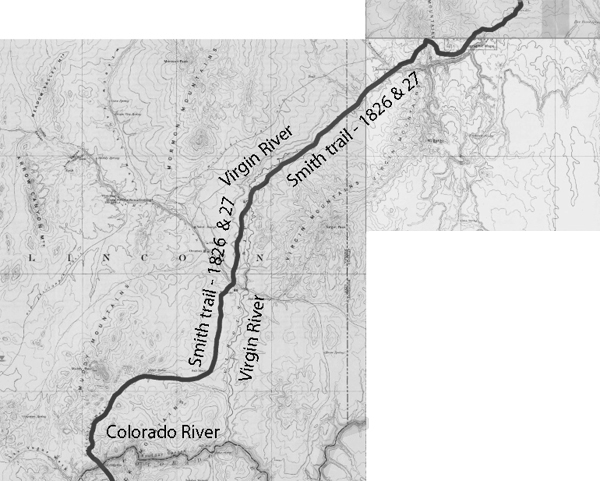
From Adams [Virgin] River to Seedskeeder [Colorado] River
The weather while here was hot, the mercury rising above blood heat. I visited Indian lodges a mile above our camp on the creek to see how they farm. Their little corn patch is close to the bank of the stream for the convenience of water. Here it is dammed, and a trunk conducts the water to a place where somebody can spread it over the surface. They use a piece of wood 3 inches wide and 4 feet long for a hoe. The pumpkins and corn were not quite ripe. Cane grass and weeds cover these small lodges with the fires kept on the outside. They hid their women and children, so I did not see one while with them. They have some crockery thinner than standard brown earthen colored yellow lead color and like stoneware. I saw no iron among them so they could make a piece into a knife or an arrow point, which was a superb acquisition. They have pipes made of fine clouded marble and a kind of tobacco like that which we in the mountains call snake tobacco. Each man smokes for himself, not passing the pipe around the circle as is the custom among the mountain Indians. They care very little about our tobacco.
Many of these Indians wore the scalp of an antelope or mountain sheep with the ears on for a hat. In actions and language, these Indians are like the Paiute.* (* From where I struck Adams River to Corn Creek, there were only a few places where timber was. What I saw was cottonwood and, in some areas, willows. The grasses were cane salt and wire grass. On Corn Creek was a large cottonwood and willow. The country on the Adams River above where I struck it had a peculiarly wild and rugged appearance. I found two or three shrubs that were new to me. On growing in bundles like a currant bush with a bright red and polished bark. Another about three feet high green bark prickly surface, and when stripped of the bark is perforated, it is hollow like a reed.)

Manzanita
Having recruited both men and horses, I moved down the river to the foot of the mountains. Then I turned off to the right, the river's course still S W winding about among the rocks and ravines. I succeeded in gaining the summit of the mountain composed of ridges of rock and gravel. But although I was so high that I could see the low ground beyond, there was a deep ravine before me, which I was obliged to cross. The descent was extremely steep, and as we had had no water since morning, I was obliged to follow the ravine to the river. It was then nearly night encamped without any grass for my horses. I killed an ibex in good order, and one of the men killed another. These relished very well with men deprived of their accustomed meat rations.
Early the following day, we started down in the bed of the general shallowness of the water. By the meanderings of the stream, it was about 12 miles through the rocks rising perpendicularly from the water's edge in most places to the height of 3 or 400 feet. There are many hot springs but not as hot as some I have seen at Salt Lake and on the Bighorn. There was some appearance of iron ore. At one place, I was obliged to unload and swim the horses. I moved about 3 miles after getting through the mountain to the bed of a stream coming in from the west on which there were some good-sized cottonwood trees.
There is little appearance of Indians in this vicinity. The country is not so rough as on the other side of the mountain but barren, and the river continues wide and shoal. At this place, I saw a new kind of quail, some smaller than the Atlantic quail. The male has three or four feathers an inch long rising from the head. Nothing new or material occurred after four days of traveling down the river. After passing the mountains, the river turns south, keeping nearly parallel with the hill at 5 miles. The grass has been somewhat plentiful along the river, with a few small cottonwood trees in two or three places. No game since we left the mountains.
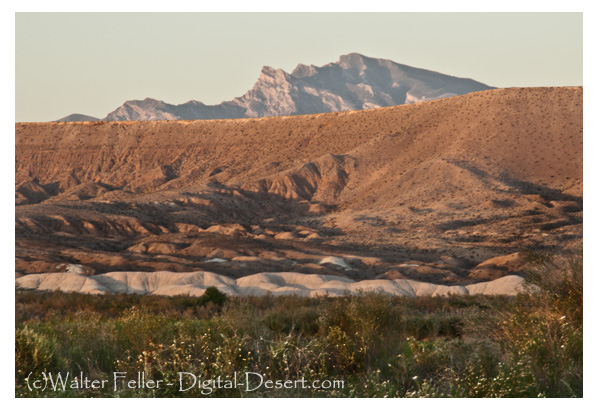
On the evening of the fourth day, I saw an Indian at a distance. I called to him, and after some hesitation, he came to me and understanding by his signals that there were some lodges nearby, we went on to the mouth of a creek from the SW, small but unfailing on the bank of which were several lodges of Indians like those on Corn Creek. They had corn, pumpkin, squash, and some small green watermelon. I soon purchased some pumpkin, squashes, and encamped. As I was weary of traveling in this barren country, I made many inquiries of the Indians as to the country ahead. They told me there was a large river not far off and plenty of beaver, for it is a general characteristic of Indians to answer your questions in the manner that they think will please you but without regard for the truth. However, there are some individuals of different tribes in the mountains on whose words you may depend. These Indians are Paiute but not as wild as those above the ranges. Their women and children did not run off.
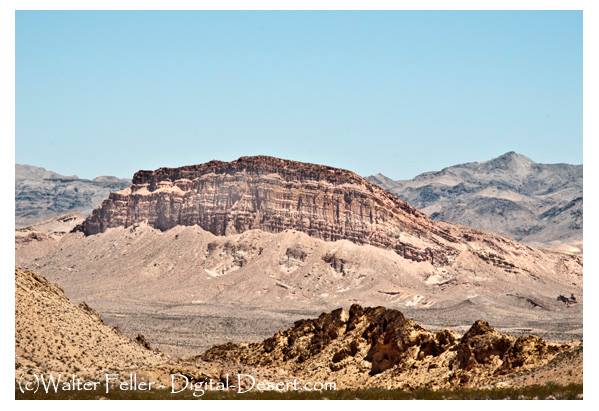
I saw at their lodges a large cake of rock salt weighing 12 or 15 lbs and, on inquiry, found that they procured it in a cave not far distant. I engaged an Indian and sent one of my men to ascertain the truth. The men reported it as accurate. I saw ocher among these Indians, procured from the N E about 30 miles. I thought I had some reason to believe these Indians concerning the beaver as they had moccasins made of the skins. There were two Indians from another tribe, apparently to trade for salt and ocher. They told me this river entered another large river from the northeast after a day's travel below here. Several days' journey below the mouth of this river, they resided where plenty of beaver and the Indians had horses. I saw on these Indians some blue yarn and a small piece or two of iron from which I judged they had some intercourse with the Spanish provinces. I engaged these Indians as guides, for I might as well go on as undertake to return.
The prospect ahead was if the Indians told me the truth that, I might, in this moderate climate, trap all winter and purchase some horses. Some of my horses had given out and were left, and others were so poor as not to be able to carry a load. These considerations induced me to abandon the idea of returning to the mountains until I should have explored the secrets of this thus far unpromising country.
------------
The Salt Cave
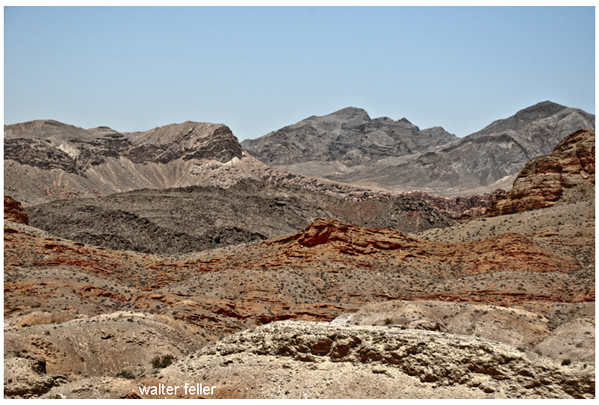

Having stayed at the mouth of this creek for two days, I started on down the river accompanied by my two guides; when I was opposite the cave, I turned off to the right across a level piece of ground about 1/2 mile to the foot of a hill which appears to be two or three miles long and 100 or 150 feet high its course being about parallel with the river which is here running S E or E S E. Ascending from the foot of the hill 80 or 90 feet I arrived at the entrance of the cave which is about 15 feet high and the same width gradually close as I advanced to 4 feet in width and 10 feet in height where it was a tricky descent for a short distance perhaps ten feet where you arrive on a floor the room then opens to about 15 or 18 feet in width 25 or 30 feet in length and 20 feet in height. The roof sides and bottom are of solid rock salt. I had brought an axe to examine it and found it generally pure but, in places, a few dark veins on breaking it. After satisfying my curiosity, I proceeded onwards a few miles and encamped.


Crossing the Colorado
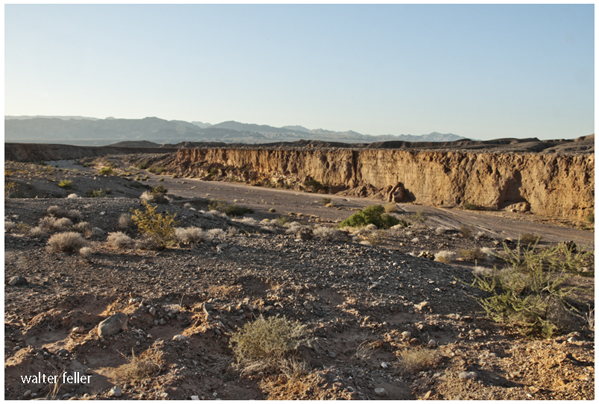
Callville Wash
The next day S E 15 miles to the large river of which my guides had spoken. It was about 200 yards wide and 73 deep and had a strong current. Coming from the N N E and this place running south, it could be no other but the Colorado of the west, which in the mountains we call seetes-kee-der. Upriver the country presents a hilly barren appearance, below and around barren stony hills. In some places are a few small trees along the bank of the Colorado. The guides said crossing the river at this place would be necessary. There, I formed a raft of driftwood to carry over my goods.

Primitive Transportation - Edward Curtis photo